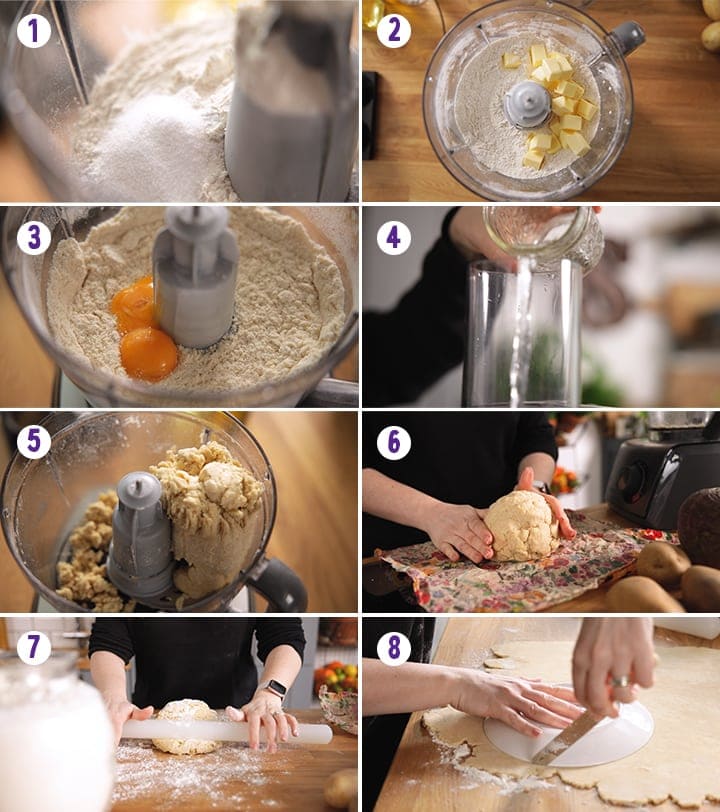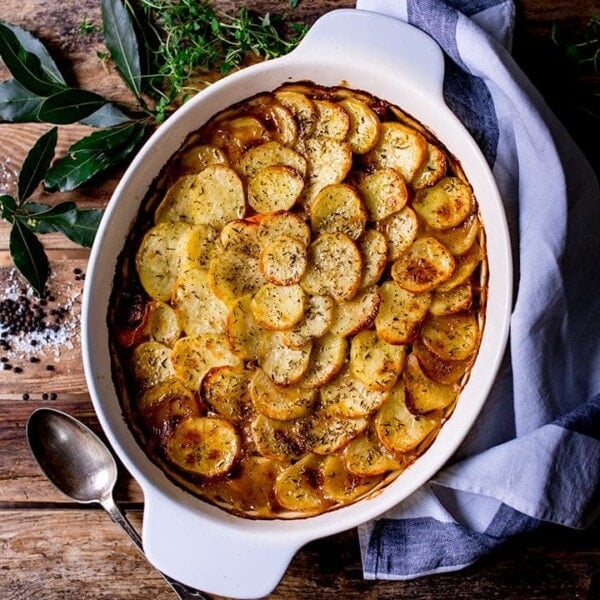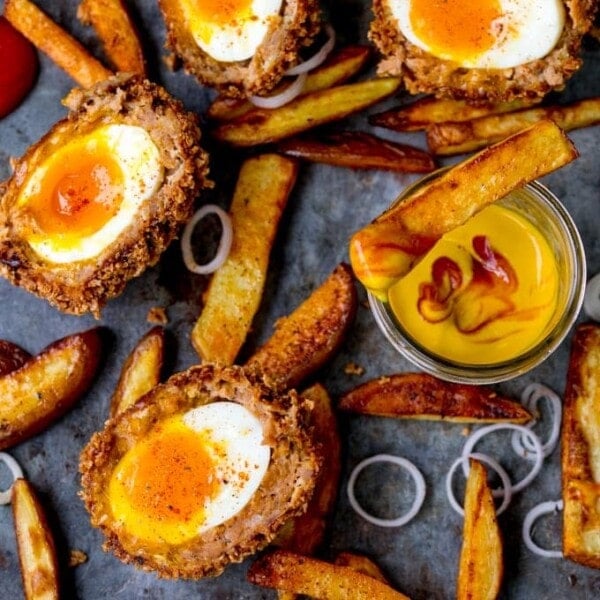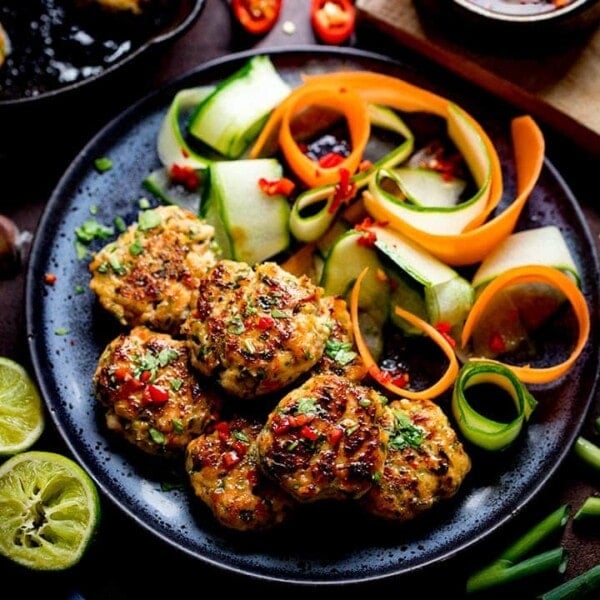Cornish Pasties with tender peppery chunks of beef mixed with melt-in-your-mouth vegetables, all wrapped up in buttery golden pastry. The Cornish Pasty is one of the most famous foods to come out of the south of England, and I can completely understand why the Cornish folk have so much pride in this tasty hand-held meal.

The Cornish pasty goes back hundreds of years, but they’re most commonly known to have been a staple food of the poorer classes going back to the 18th century. Miners used to take the pasties into the tin mines, and they’d be nutritious and filling enough to keep the workers going all day.
The specific shape of the pasty was thought to have come around for good reason too.
The crimped crust on the side was used as a kind of handle. The levels of arsenic in the tin mines meant that the miners hands would be grubby and likely covered in this highly toxic substance. So the miners would hold onto the crust to eat their pastie, and then discard it (which is a shame! I LOVE the crust!!).
Table of Contents
📋 Ingredients

Beef – Skirt steak, sirloin or ribeye are the best cuts for the most tender and juicy meat for a Cornish pasty filling. Don’t be tempted to use braising/chuck/stewing beef or the meat will be chewy and tough. (Note: skirt steak can be a little on the tough side, but small pieces that have been cut against the grain will still be plenty tender enough.)
📺 Watch how to make it
***Full recipe with detailed steps in the recipe card at the end of this post***
- First, we make the shortcrust pastry. This is a basic shortcrust pastry, so you can replace it with shop-bought if you prefer (see notes in the recipe card for more info). Place flour, baking powder and salt into a food processor and give a quick mix.
- Add in cubed butter and whizz until the mixture turns into breadcrumbs.
- Add in egg yolks and mix, then, with the motor on, add in water a bit at a time until the dough comes together into a ball.
- Wrap the pastry in clingfilm or wax paper (<– affiliate link) and refrigerate for an hour.
- Roll out the pastry and cut circles into the dough using a side plate as a template.

- Mix cubed potato, swede (rutagaba), onion, steak, salt and pepper in a large bowl.
- Place a really good handful of the mixture onto one side of one of the pastry circles and dot a little butter on top.
- Brush egg wash around the edge of the pastry circle and fold the other side of the pastry over the meat until the edges meet and you have a semi-circle.
- Seal firmly and crimp with your fingers (check out my video below to see how to do this).
- Make a little hole in the top of the pasty using a sharp knife to let out the steam. Repeat with the remaining pasties and then brush egg wash over the top of all the pasties.

- Bake for 50 minutes until golden brown.
Pro Tip
These Cornish Pasties are filled with a mixture of well-seasoned steak, onions, potatoes and swede (or rutabaga/yellow turnip if you’re in the US). The meat and vegetables are placed in the pastry raw, with a really good pinch of salt and pepper and a few dots of butter, then sealed and cooked in the pastry. There’s no sauce inside a Cornish pasty, but the cooked filling ends up so tender and moist that it’s not needed.
We’re using a good quality cut of beef, so it only needs light cooking inside the pasty. The juices that are released from the meat during cooking will flavour the vegetables and make the filling lovely and juicy.

Pin this now to find it later
Pin It🍽️ What to serve it with
- The best way to have a cornish pasty is with a large dollop of ketchup.
- However, you can also serve it with Air Fryer Chips. And if you can’t live without gravy, I’ve got a homemade gravy recipe for you.
Even though I’m a gravy superfan, I think it’s ketchup that’s a must for Cornish Pasty dipping. Well, that’s my opinion anyway.

🍲 More British classics
? Frequently Asked Questions
Yes, make and cook the pasties, then cool, cover and refrigerate them. Reheat in the oven, uncovered, at 190C/375F for 30 minutes, until piping hot throughout.
Yes, make and cook the pasties, then cool, cover and freeze.
Defrost in the refrigerator overnight. Reheat in the oven, uncovered, at 190C/375F for 30 minutes, until piping hot throughout.
Pastry:
You can replace the homemade pastry with shop-bough shortcrust pastry.
Beef:
Skirt steak, sirloin or ribeye are the best cuts for the most tender and juicy meat for a Cornish pasty filling. Don’t be tempted to add braising/chuck/stewing beef or the meat will be chewy and tough. (Note: skirt steak can be a little on the tough side, but small pieces that have been cut against the grain will still be plenty tender enough.)
Stay updated with new recipes!
Subscribe to the newsletter to hear when I post a new recipe. I’m also on YouTube (new videos every week) and Instagram (behind-the-scenes stories & beautiful food photos).

Cornish Pasties
Ingredients
Pastry:
- 450 g (3 2/3 cups) plain (all-purpose) flour plus a couple of tbsp extra for rolling out the pastry and sprinkling on the tray later
- 2 tsp baking powder
- 1 tsp salt
- 125 g (1/2 cup + 1 tsp) unsalted butter chopped into chunks
- 2 egg yolks
- 125 ml (1/2 cup + 1 tsp) cold water
Filling:
- 450 g (1 lb) potato peeled and finely diced
- 150 g (1/3 lb) swede/rutagaba peeled and finely diced
- 150 g (1/3 lb) onion peeled and finely chopped
- 300 g (2/3 lb) skirt steak or sirloin steak finely chopped, with fat discarded (weigh the meat after discarding the fat)
- 1 tsp salt
- 1 tsp ground black pepper
- 3 tbsp unsalted butter chopped into small cubes
- 1 egg beaten
Instructions
- First, make your pastry. Place the flour, baking powder, and salt into a food processor and give a quick mix.450 g (3 2/3 cups) plain (all-purpose) flour, 2 tsp baking powder, 1 tsp salt
- Add in the butter and whizz until the mixture turns into breadcrumbs.125 g (1/2 cup + 1 tsp) unsalted butter
- Add in the egg yolks and mix, then, with the motor on, add in the water a bit at a time until the dough comes together into a ball. You may not need all the water.2 egg yolks, 125 ml (1/2 cup + 1 tsp) cold water
- Take the pastry out of the food processor, wrap it in clingfilm or wax paper (<–affiliate link) and refrigerate for an hour.
- Preheat your oven to 180C/350F (fan). Take two large baking trays and sprinkle them with some flour.
- Take your pastry out of the fridge and roll it out on a floured surface until you get a thickness you can cut, that won't tear easily. I find that's about 3mm.
- Cut circles into the dough using a plate that is about 20-21cm (approx 8") in diameter as a template. I find that I get 3 circles out of the first lot. Then I re-roll and get 2 circles, and then I re-roll and get one final circle. You can place the circles stacked onto a plate so long as you have a sprinkling of flour between each layer.
- In a large bowl, mix your potato, swede/rutagaba, onion, steak, salt, and pepper.450 g (1 lb) potato, 150 g (1/3 lb) swede/rutagaba, 150 g (1/3 lb) onion, 300 g (2/3 lb) skirt steak or sirloin steak, 1 tsp salt, 1 tsp ground black pepper
- Take one of your pastry circles and place it onto your work surface. Place a really good handful of the meat mix onto half of the circle, leaving a 2cm border around the edge. It'll look like a lot of mixture, but it needs to be packed full.
- Dot 1 1/2 tsp butter (from the 3 tbsp butter) on top of the meat and veg pile.3 tbsp unsalted butter
- Take your beaten egg, and using a pastry brush, paint a little of the egg wash around the edge of the circle. This will help the pastry stick together.1 egg
- Now, fold the other side of the pastry over the meat until the edges meet and you have a semi-circle. Seal firmly and crimp with your fingers (check out my video above to see how)
- Place your pasty onto your baking tray and make a little hole in the top using a sharp knife to let out the steam. Repeat with the remaining pasties.
- Brush the remaining egg wash over the top of the pasties and place in the oven for 50 minutes until golden brown.
- Take out of the oven and leave to cool for 5 minutes before eating.
Video
Notes
Can I make them ahead?
Yes, make and cook the pasties, then cool, cover and refrigerate them. Reheat in the oven, uncovered, at 190C/375F for 30 minutes, until piping hot throughout.Can I freeze them?
Yes, make and cook the pasties, then cool, cover and freeze. Defrost in the refrigerator overnight. Reheat in the oven, uncovered, at 190C/375F for 30 minutes, until piping hot throughout.Can I use shop-bought pastry?
Yes, you can replace the homemade pastry with shop-bough shortcrust pastry.The best cut of beef for Cornish Pasties
Skirt steak, sirloin or ribeye are the best cuts for the most tender and juicy meat for a cornish pasty filling. Note: skirt steak can be a little on the tough side, but small pieces that have been cut against the grain will still be plenty tender enough. Don’t be tempted to add braising/chuck/stewing beef or the meat will be chewy and tough. .Recipe Source:
Adapted from a Hairy Bikers recipe Nutritional Information is per pasty.Nutrition
Nutrition information is automatically calculated, so should only be used as an approximation.
This post was first published in August 2014. Updated in March 2025 for housekeeping.
Some of the links in this post may be affiliate links – which means if you buy the product I get a small commission (at no extra cost to you). If you do buy, then thank you! That’s what helps us to keep Kitchen Sanctuary running. The nutritional information provided is approximate and can vary depending on several factors. For more information please see our Terms & Conditions.
























I’ve never tasted rutabaga in my life. What would you say it tastes like?
I cannot describe how they taste, all I can tell you is that in the Midlands where I come from we mash them with carrots and a little butter and salt and pepper and it tastes divine !!! Try it one day, you will love it !!
Mhmmm I’ve never had cornish pastries before, but this looks DIVINE! Any combination with steak and potatoes is a big winner in my books!
Gorgeous photos and great recipe :)!
Thanks Christine 🙂
Love Cornish pasties! I was in Las Vegas recently and by chance saw a Cornish Pasty Co. restaurant, but I just had a big lunch, so didn’t stop to give it a try. Of course a few hours later I wish I had, could have gotten a take out. I’ve been thinking of pasties since then (it’s true!). Thank goodness I now have your recipe so I can make my own. They look so yummy, Nicky, better than the ones I had in London! 🙂
Thanks 🙂 I was really pleased with them. I’ve seen a recipe using bread flour too. The additional gluten is supposed to make for a stronger, stretcher pastry – meaning you can roll it a little thinner I guess. That’s next on my list to try when I make these again.
I have never heard of it before (probably because I’m not from England) but it looks so good!
It really is Sarah (especially with a little dollop of ketchup). Hope you give it a go 🙂
Some of those Cornish miners migrated to the Upper Penninsula in the 1800’s and brought with them the “pasty”. They are very popular up north in Michigan and down here in the southern part (where I live) 🙂
ooh great to get the next instalment on the history of the Cornish pasty 🙂 I didn’t realise they’d made it so far out of the UK!
When the Cornish miners came to the Upper Peninsula, in Michigan, they started working in the copper mines here as these mines were aplenty with no trained or skilled laborers available. They brought their wonderful pasty recipe with them. The mines were initially located in an area now referred to as “Copper Harbor!” Ironic! Every once in awhile, a Finn will try to take some credit for the pasty, but usually, I believe, some one of Cornish heritage will run them out of town. No, just joking! Recipes do change according to family history, likes/dislikes, so most recipes will have a little deviation here or there. Our region is a cold one with the first snowfall beginning as early as October 1st and lasting until frost is finally gone around end of May. Root and hardy vegetables, used in pasties, grow better here than vegetables growing above the ground. There is a Cornish man, from your area, a Mr. Billy Deacon, who states that he has won 1st place in the World Cornish Pasty contest, in 2012 and 2013, saying his recipe must be pretty good as he won first place two years in a row. I ordered his book, on line, today and I’ll see what he says about ingredients, for my own curiosity. Then our weekly local newspaper just had an article about a woman, who says she was the Queen of Pasties, as she has been making them for years and once made and filled an order for one thousand. The news had also posted her “famous” recipe. I didn’t really care for it myself as it has 16 cups of cubed potatoes, 2 heaping cups of carrots, and 2 cups of diced celery (where did they come from…I know- Newberry is the actual Celery Capital of Michigan as well as the Moose Capital too!) and nary a rutabaga/swede in sight. Unfortunately this woman, a Mrs. Marcella Norman, passed away in 2019. According to her daughters, she owned the recipe, and because she had passed away they allowed our newspaper to post her recipe. On the other hand, Mr. Billy won’t post his recipe as he would prefer that people would purchase his book (and he sure got me! the book went right into my shopping cart ) I found some of your other recipes intriguing so I wrote several down, to make in the future. Many thanks for providing these recipes. Well, now you know a little more Michigan history too …….
Martha Simmonds McNeal
never tried cornish pasties before, your recipe looks soooo scrumptious, will definitely give it a try….thanx for the recipe… Happy FF
Thanks Chitra, hope you enjoy them, let me know how you get on 🙂
Thanks for bringing a recipe for something I have never made before. I have only had store bought ones, but I think to get the real thing, I would have to make it myself. Not so different from empanadas, which I make often, but It’s high time I tried these. That golden colour is beautiful.
Thanks Hilda, hope you like them 🙂
Will try soon.. Thanks for the recipe
Hope you like them, let me know how you get on 🙂
Looks like straight from a gourmet bakery! I love that your daughter said she likes this more than ice cream! Happy FF!
Thanks for the lovely compliment Lisa 🙂 Happy FF to you too!
Nice and filling.
They certainly are very satisfying 🙂